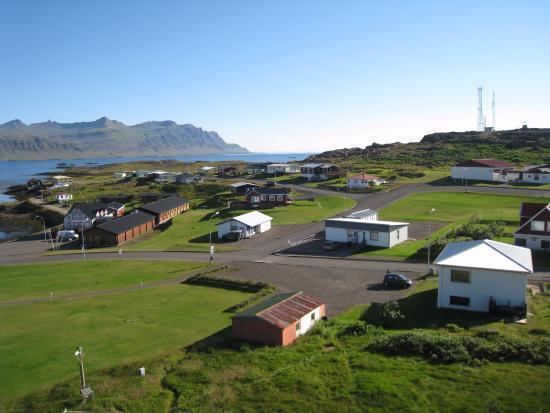Constituency Northeast Constituency Population 456 Municipal number 7617 Area 1,133 km² Postal code 765 | Manager Gauti Jóhannesson Density 0.41/km (1.1/sq mi) Website djupivogur.is Local time Thursday 3:31 AM | |
 | ||
Weather -1°C, Wind NW at 13 km/h, 86% Humidity | ||
Djúpivogur is a small town and municipality (Djúpavogshreppur) located on a peninsula in the Austurland in eastern Iceland, near the island of Papey and on the fjord Berufjörður. The municipality was formed by the merger of rural communities Berunes, Buland, and Geithellur on October 1, 1992. The coastline consists of three fjords Berufjörður, Hamarsfjörður, and Álftafjörður. The town of Djúpivogur is located on a peninsula between Berufjörður and Hamarsfjörður.
Contents
Map of Dj%C3%BApivogur, Iceland
Approximately 900m west of the town is a work of art named "Eggin í Gleðivík" (The Eggs of Merry Bay) by Sigurður Guðmundsson. The work is a replica of the eggs of 34 nesting birds in the area, and was installed in the summer of 2009.
Climate
Approximately 5 kilometres west of Djúpivogur lies Teigarhorn, a farm on the shores of Berufjörður, where weather observations has been commenced since 1874. It is one of the oldest weather stations in the country and holds the record for the highest temperature ever recorded in Iceland, 30.5 °C (87 °F) recorded on June 22, 1939. It is also claimed that Teigarhorn reached 36.0 °C (97 °F) in September 1940, but that is not recognized by the Icelandic Meteorological Office. Temperatures above 30 °C (86 °F) are very rare in Iceland, it has occurred only 5 times since weather observations were first commenced in Iceland in the 19th century. Teigarhorn features a tundra climate (ET) because it doesn't have any month that has a mean temperature above 10 °C (50 °F), but the winter temperatures are mild for a tundra climate, and thus closely resembles a subpolar oceanic climate (Cfc), the climate generally seen in coastal Iceland.
History
By the early nineteenth century, Djúpivogur was 'a tiny port with a Danish colonial trading base'. Hans Jonatan, who had been a slave in Copenhagen, escaped there and became one of Iceland's first people of colour.
Culture
Djúpivogur is the first and only Cittaslow town in Iceland. Cittaslow's goals include improving the quality of life in towns by slowing down its overall pace, especially in a city's use of spaces and the flow of life and traffic through them. Cittaslow is part of a cultural trend known as the slow movement.
